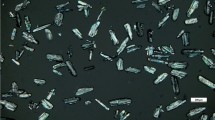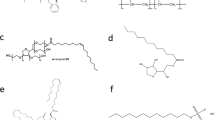Abstract
The aqueous solubility of poorly water-soluble drugs is an important property of many factors affecting their bioavailability such as the solubility and rate of dissolution in water. The quantitative structure-property relationship approach using genetic algorithm was applied to make models for predicting some poorly water-soluble drugs such as ursodeoxycholic acid, diphenyl hydrantoin and biphenyl dimethyl dicarboxylate. The experimental solubility data of 3518 chemical structures were collected from the web and used to build a model. Three data sets of 50 compounds were extracted according to their structural similarity with each drug. A fast and predictive similarity based approach was developed and validated with conventional method. This can be used to predict the aqueous solubility for drugs by using a small set of compounds, especially for poorly water-soluble compounds. Moreover, the estimation values of various sets were further compared with fine grinding experiment data.
Similar content being viewed by others
References
M. J. Sung, B. J. Cha, W. S. Choi, J. H. Kim and S. H. Choi, The 43 rd symposium on powder science and technology, Busan, Korea (2005).
J. H. Kim, D. H. Jung, H. K. Rhee, S.H. Choi, M. J. Sung and W. S. Choi, Korean J. Chem. Eng., 25, 171 (2008).
C. A. Lipinski, F. Lombardo, B.W. Dominy and P. J. Feeney, Adv. Drug Deliv. Rev., 23, 3 (1997).
J. C. Dearden, Chemom. Intell. Lab. Syst., 24, 77 (1994).
W. L. Jorgensen and E. M. Duffy, Adv. Drug Deliv. Rev., 54, 355 (2002).
J. Taskinen and J. Yliruusi, Adv. Drug Deliv. Rev., 55, 1163 (2003).
R. D. Cramer, J. Med. Chem., 46, 374 (2003).
ChemIDplus, http://chem.sis.nlm.nih.gov/chemidplus/.
PubChem, http://pubchem.ncbi.nlm.nih.gov/.
Cerius2., Accelrys, San Diego, CA.
L. H. Hall and L.B. Kier, J. Chem. Inf. Comput. Sci., 35, 1039 (1995).
J. Devillers, Genetic algorithms in molecular modeling, Academic Press, San Diego (1996).
B. E. Mitchel and P. C. Jurs, J. Chem. Inf. Comput. Sci., 38, 489 (1998).
D. T. Stanton and P. C. Jurs, Anal. Chem., 62, 2323 (1990).
R. H. Rohrbaugh and P. C. Jurs, Anal. Chim. Acta, 199, 99 (1987).
W. Arlt, Private communication on the prediction of thermo-physical data, University of Erlangen, Germany (2005).
Author information
Authors and Affiliations
Corresponding author
Rights and permissions
About this article
Cite this article
Kim, J., Jung, D.H., Rhee, H. et al. Aqueous solubility of poorly water-soluble drugs: Prediction using similarity and quantitative structure-property relationship models. Korean J. Chem. Eng. 25, 865–873 (2008). https://doi.org/10.1007/s11814-008-0143-x
Received:
Accepted:
Published:
Issue Date:
DOI: https://doi.org/10.1007/s11814-008-0143-x




